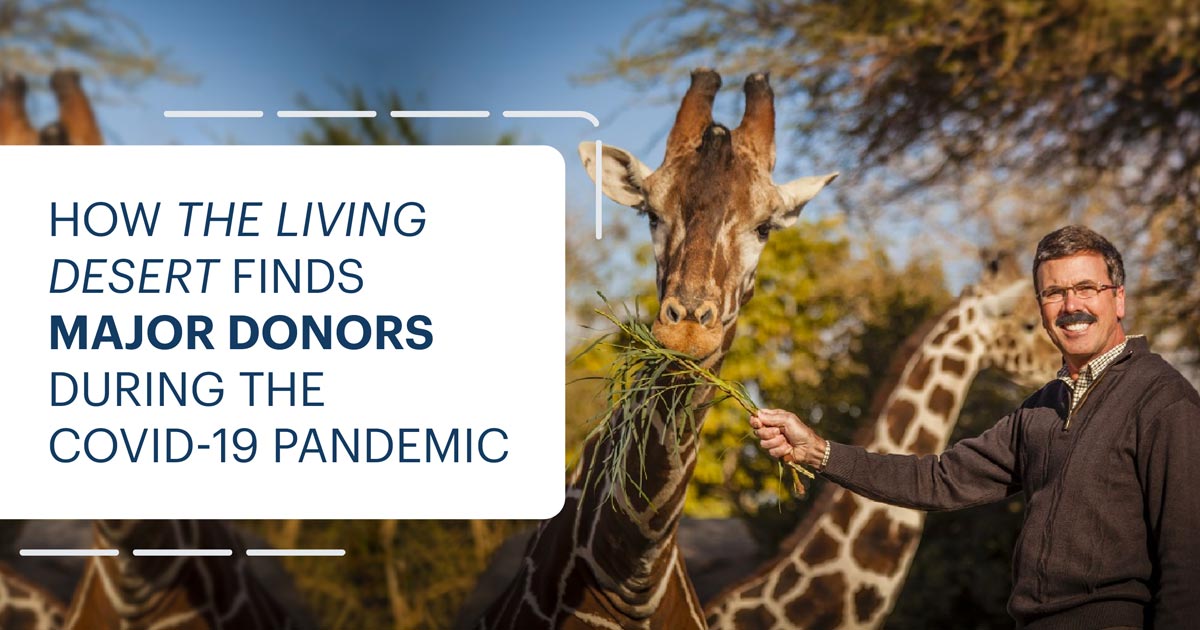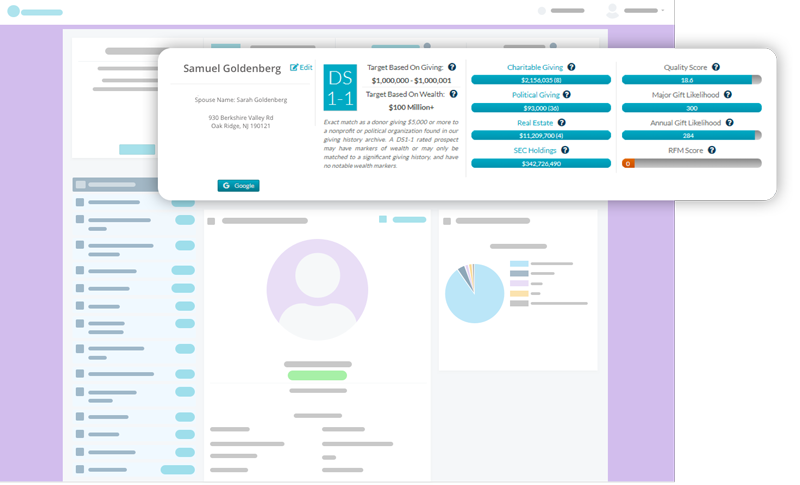
As a botanical garden and zoo, The Living Desert actively protects the desert wildlife of Southern California. When COVID-19 lockdowns first went into effect, the staff had no choice but to shutter their doors and forgo the admission fees they relied on. After making several budget cuts, the team needed to start fundraising.
While donors continue to face financial hardship, nonprofit professionals struggle with whether it’s a good time to ask for donations. But organizations like The Living Desert stress that they cannot simply stop fundraising, because their animals required daily care, and once restrictions lifted, their community would need them more than ever! Their first step forward? Finding major donors to support their operations costs and help them achieve their $2M emergency fundraising goal.
Why is major donor fundraising important?
On average, more than 88% of all nonprofit revenue comes from just 12% of donors: major donors. Plus, efforts to retain major donors can be well worth your time, as they’re the most likely donor population to increase their giving amount after their first gift.
To learn how nonprofits can use major donor research to find capable donors even through times of crisis, we spoke with the staff members of The Living Desert who’ve been tasked with fundraising through the COVID-19 pandemic. You, too, can track down major donors by applying the moves they made to your major donor outreach strategy:
#1. Determine a specific need and set your goal
Major donors want to know exactly how you plan to allocate funds. That means the fundraising goal you communicate should be clear, specific, and measurable. Although you may feel like you can use all the help you can get, decide on one area of need to keep your campaign and messaging focused.
To set their fundraising goal, the team at The Living Desert mapped out exactly what they needed to maintain operations in a specified time period. Senior Manager of Development Amy Crabb explains, “Prior to closure, it cost about $45,000 a day to run the zoo. Once we reduced to essential staff, we got down to bare bones, so then it was about $22,000 a day to run the zoo. We basically took that time, an arbitrary 90 days we thought we might be closed, and came up with a $2 million goal.”
Totaling up the cost of your needs helps major donors plan for how much of the goal they’d like to fund. By being transparent about the measures your team takes to maximize dollars raised, you’re likely to find that major donors will be extra generous.
#2. Define what “major gift” means for your organization
With a set baseline for major gifts, you can establish protocols that give clear direction to all your staff about how to treat major donors and standardize the way you measure the success of your major donor outreach efforts. What gift levels warrant a personal phone call, who will be featured on your donor wall – there will be no question about which donor relationships need a little extra attention.
Here’s a formula you can try to calculate a baseline for your organization’s major gifts using your fundraising data:
- Run a report of your top ten gifts last year
- Exclude outliers (gifts excessively large, comparatively)
- Exclude corporations and foundations
- Sum the ten gifts and divide that number by ten for the average
- Round up! (If your average is $4,300, make it $5,000)
#3. Perform prospect research
No major gifts officer? No problem. Although they lost their researcher due to unavoidable layoffs, The Living Desert team was able to exceed their fundraising goal, thanks to their experience with donor development and intuitive donor research tools.
According to BWF’s 2020 Fundraising Report, only 27% of fundraising professionals are using wealth data to identify new major donor prospects. However, an incredible two-thirds of those who’ve used it reported having success. It’s safe to say that crafting a campaign to engage these donors is a must.
#4. Strategize with your team
Finding new major donors can be a lot like looking for a needle in a haystack. In a major gift fundraising campaign, you’ll need to brainstorm with your team about how you’ll optimize your outreach.
Given the urgent need to find an alternative revenue source to maintain their animals’ care, The Living Desert had to rely more heavily on fundraising. As a team, they planned an immediate strategy of segmenting their existing donors and making specific asks based on their prior gifts. This became the catalyst of their fundraising success.
Getting together as a team to share ideas can be the start of something amazing! Consider discussing the resources each member brings to the table and how they can be utilized in your fundraising campaign. You may discover that a board member has a major donor connection they can approach directly or that a staff member’s relative can provide a useful skill.
#5. Uncover major donors you already have

Before you go to the ends of the Earth searching for new major donors, look to the supporters in your database. With the information you have, a wealth screening can tell you who among them has the capacity to fund your most critical needs. Even without having all the details, wealth data tools can fill in the blanks for you.
For example, it’s common for individuals to establish a fundraiser on your behalf via their personal Facebook page. However, the donor data Facebook provides (first name, last name, and email address) is not enough to get a complete picture of the generous people – sometimes perfect strangers – who are compelled to donate to your cause.
The Living Desert was fortunate to receive almost $22,000 in gifts from over 450 Facebook fundraisers alone, hosted by supporters and staff alike. With the limited information Facebook could provide about the donors, the team decided to perform wealth screenings for donors who had given a gift with an amount in the top 30% to decide whether or not to re-engage them. Annual Giving Officer, Lexi Ward tells us, “We either initiated a brand new or updated DonorSearch on every single one of those donors to see where their interests were, what their capacity is. We had to prioritize how we’re going to interact with all of those donors.”
Amy added, “I think the big thing that DonorPerfect and DonorSearch is going to allow nonprofits to do is to really work smarter by segmenting our markets, by looking at where people have given, how much they’ve given… using the tools that are available, and figuring out how to work smarter with less is going to be imperative for the next two or three years until we can get going, get back up to where we were. It’s going to be hard for a while.”
#6. Find new donors with prospect lists
Not sure where to begin with major donor fundraising? Start with prospect lists. With DonorSearch, you can select from an array of criteria, like affinity for causes in your sector or potential donors with a net worth of over a specified amount. This way, you can be more strategic in your search for major donors.






#7. Set up a social media strategy
Putting yourself out there for major donors to find you on their own can be a great way to uncover unexpected prospects. Without the ability to personally communicate with each of them, you’ll reach a broader audience more quickly with digital marketing tactics, such as Facebook ads and public posts. In fact, 85% of millionaires say they use social media, so it’s crucial to share your message where they’ll see it.
Identify your audience
Who are these unnamed major donors? Though you won’t know exactly who your digital ads are reaching, create a persona of a major donor prospect that will act as an example you can tailor your messaging to. Not sure what to say to this imaginary person? Try surveying the major donors you have to learn what resonates with them.
Incorporate video
80% of all media consumption is via video. Add to that the fact that a Google study found that 57% of those who watch video go on to donate to that cause. Needless to say, your digital marketing strategy should include a video element.
Select the “face” of your campaign
Choose a subject for your video, who will speak directly to the audience. This can be someone your mission has helped, a member of your volunteer community, your CEO, etc. Then, select an impact story to tell.
The team at The Living Desert reflected on the passions of their existing donors to determine what would resonate with potential major donors. Amy explains, “Development department was not the face of the zoo. We decided our CEO was our main face, and it was going to be our animal keepers and our animals, because that’s what people care about.”